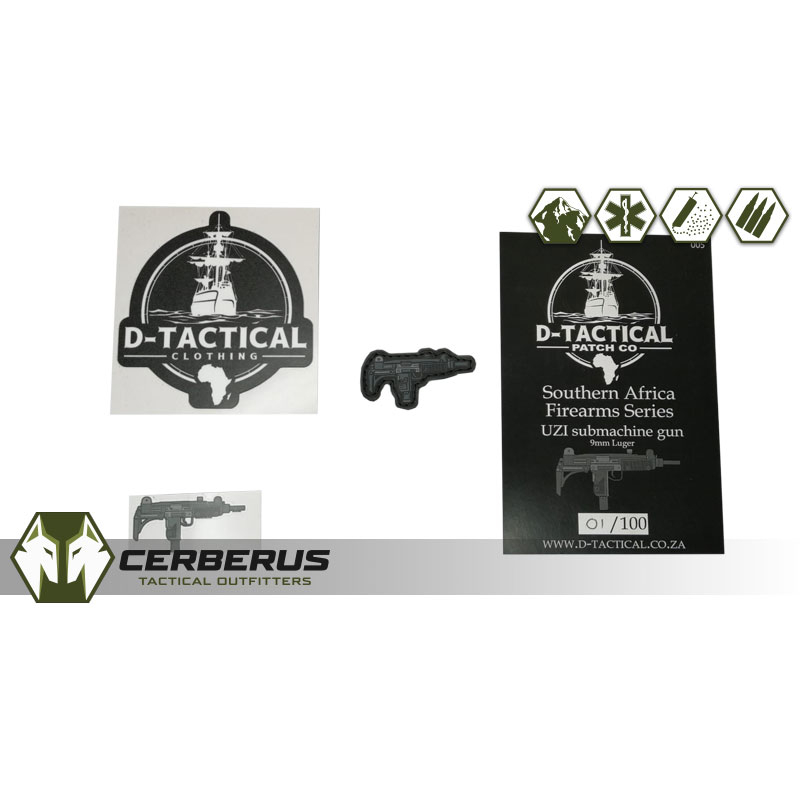
Reference: APP-181009-034
Brand: Condor Outdoor
Condor Keep Calm and Carry On PVC Patch
Condor Keep Calm and Carry On PVC Patch
Banner

No Events



Valid from 1 May - 31 October 2025
D-Tactical Southern Africa Firearms Series PVC Patch #005 - UZI
Includes:
Velcro Backed PVC Patch
Numbered Art Card
Limited run Sticker
D-Tactical Sticker
The Uzi is a family of Israeli open-bolt, blowback-operated submachine guns. The Uzi was one of the first weapons to use a telescoping bolt design which allows the magazine to be housed in the pistol grip for a shorter weapon.
The first Uzi submachine gun was designed by Major Uziel "Uzi" Gal in the late 1940s shortly after the establishment of the State of Israel. The prototype was finished in 1950. First introduced to Israel Defense Forces (IDF) special forces in 1954, the weapon was placed into general issue two years later. The IDF supplied Uzis to rear-echelon troops, officers, artillery troops and tankers, as well as a frontline weapon by elite light infantry assault forces.
The Uzi has been exported to over 90 countries. Over its service lifetime, it has been manufactured by Israel Military Industries, FN Herstal, and other manufacturers. From the 1960s through the 1980s, more Uzi submachine guns were sold to more military, law enforcement and security markets than any other submachine gun ever made.
The Uzi uses an open-bolt, blowback-operated design, quite similar to the Jaroslav Holeček-designed Czech ZK 476 (prototype only)[15] and the production Sa 23, Sa 24, Sa 25, and Sa 26 series of submachine guns. The open bolt design exposes the breech end of the barrel, and improves cooling during periods of continuous fire. However, it means that since the bolt is held to the rear when cocked, the receiver is more susceptible to contamination from sand and dirt. It uses a telescoping bolt design, in which the bolt wraps around the breech end of the barrel.[16] This allows the barrel to be moved far back into the receiver and the magazine to be housed in the pistol grip, allowing for a heavier, slower-firing bolt in a shorter, better-balanced weapon.[14]
The weapon is constructed primarily from stamped sheet metal, making it less expensive per unit to manufacture than an equivalent design machined from forgings. With relatively few moving parts, the Uzi is easy to strip for maintenance or repair. The magazine is housed within the pistol grip, allowing for intuitive and easy reloading in dark or difficult conditions, under the principle of "hand finds hand". The pistol grip is fitted with a grip safety, making it difficult to fire accidentally. However, the protruding vertical magazine makes the gun awkward to fire when prone.[16] The Uzi features a bayonet lug.[17]
The non-reciprocating charging handle on the top of the receiver cover is used to retract the bolt. Variants have a ratchet safety mechanism which will catch the bolt and lock its movement if it is retracted past the magazine, but not far enough to engage the sear. When the handle is fully retracted to the rear, the bolt will cock (catch) on the sear mechanism and the handle and cover are released to spring fully forward under power of a small spring. The cover will remain forward during firing since it does not reciprocate with the bolt. The military and police versions will fire immediately upon chambering a cartridge as the Uzi is an open bolt weapon.
There are two external safety mechanisms on the Uzi. The first is the three-position selector lever located at the top of the grip and behind the trigger group. The rear position is "S", or "safe" (S = Sicher or Secure on the MP2), which locks the sear and prevents movement of the bolt.
The second external safety mechanism is the grip safety, which is located at the rear of the grip. It is meant to help prevent accidental discharge if the weapon is dropped or the user loses a firm grip on the weapon during firing.
The trigger mechanism is a conventional firearm trigger, but functions only to control the release mechanism for either the bolt (submachine gun) or firing pin holding mechanism (semi-auto) since the Uzi does not incorporate an internal cocking or hammer mechanism. While the open-bolt system is mechanically simpler than a closed-bolt design (e.g. Heckler & Koch MP5), it creates a noticeable delay between when the trigger is pulled and when the gun fires.
The magazine release button or lever is located on the lower portion of the pistol grip and is intended to be manipulated by the non-firing hand. The paddle-like button lies flush with the pistol grip in order to help prevent accidental release of the magazine during rigorous or careless handling.
When the gun is de-cocked the ejector port closes, preventing entry of dust and dirt. Though the Uzi's stamped-metal receiver is equipped with pressed reinforcement slots to accept accumulated dirt and sand, the weapon can still jam with heavy accumulations of sand in desert combat conditions when not cleaned regularly.[18] The magazine must be removed prior to de-cocking the weapon.
The Uzi was made in South Africa under license and was called the S1
They were issued to members of the South African Police, SAPSTF, SADF aswell as the South Africa Railways Police
 The SARP STF operators wings featured an UZI in its design
The SARP STF operators wings featured an UZI in its design

SARP STF member with UZI
Limited run of only 100 patches, once they are sold out - they will not be made again.
Reference: APP-181009-034
Brand: Condor Outdoor
Condor Keep Calm and Carry On PVC Patch
Reference: patch-00255-multicam
Brand: MIL-SPEC MONKEY
MSM We Can Do It Cute PVC Morale Patch (Color: Multicam)
Reference: DTAC-RRFLAGBK
Brand: D-Tactical
D-Tactical RSA PVC Velcro Flag Patch (Black)
Reference: DTAC-WORLD-ZAM
Brand: D-Tactical
D-Tactical World Series Printed Flag Patch - United States
Reference: TAC-BK-PATCH
Brand: Raging Rhino
Raging Rhino "Airsoft King" PVC Patch
Reference: DTAC-SANDF-TR
Brand: D-Tactical
D-Tactical RSA PVC Velcro Flag Patch SANDF Size (Traditional Colours)
Reference: TAC-243-002
Brand: Condor Outdoor
Condor Gear Patch - Black
Reference: APP-181011-034
Brand: Condor Outdoor
Condor Stay Classy PVC Patch
Reference: DTAC-PATCH-009
Brand: D-Tactical
D-Tactical Southern Africa Firearms Series PVC Patch #009 - Vektor Z88
Reference: DTAC-PATCH-500-OG
Brand: D-Tactical
Weapons are part of my religion is a memorable quote said by Din Djarin after being asked to put his weapons down.
Reference: D-TAC-G1K1-R4
Brand: D-Tactical
D-Tactical G1K1 R4 PVC Morale Patch
Reference: patch-00215-fullcolor
Brand: MIL-SPEC MONKEY
MSM Fur Missile PVC Morale Patch (Color: FullColor)
Reference: DTAC-RRFLAGMC
Brand: D-Tactical
D-Tactical RSA PVC Velcro Flag Patch (Subdued Colors)
Reference: TAC-FIG11-PATCH
Brand: Raging Rhino
Raging Rhino "Figure 11" Target PVC Patch
Reference: 2750-CB
Brand: Rothco
Rothco Tactical Key Clip - Coyote Brown
Reference: DTAC-RRFLAGGR
Brand: D-Tactical
D-Tactical RSA PVC Velcro Flag Patch (Stealth Grey Colors)
